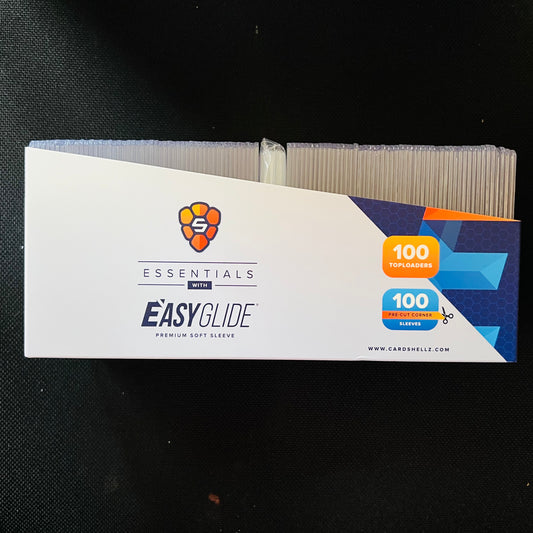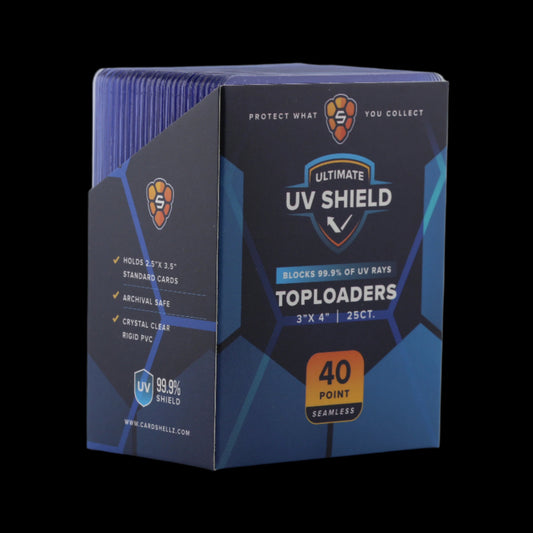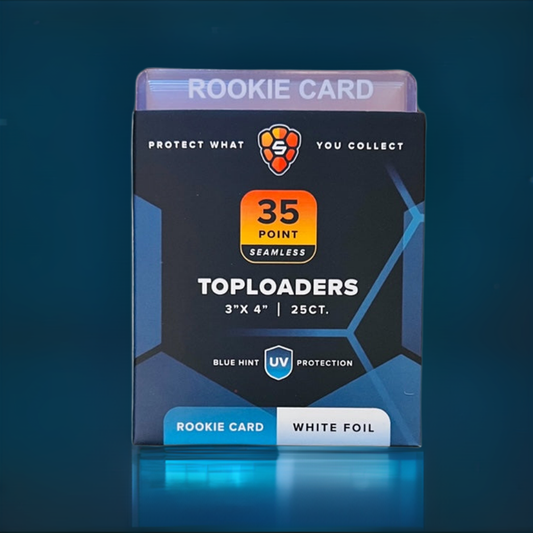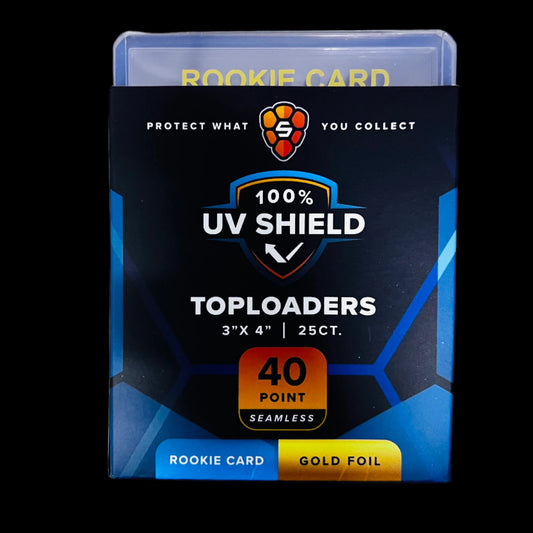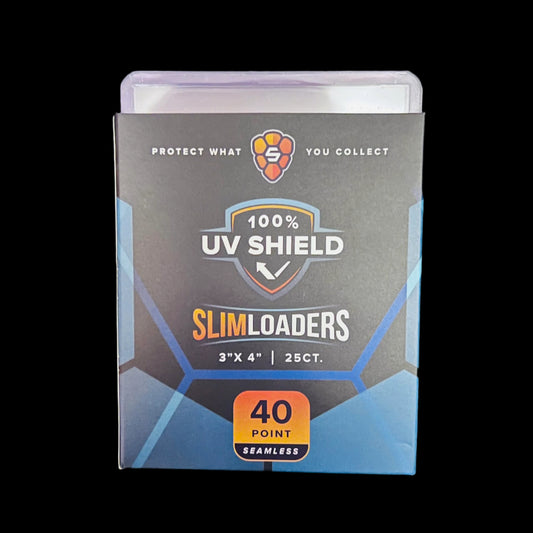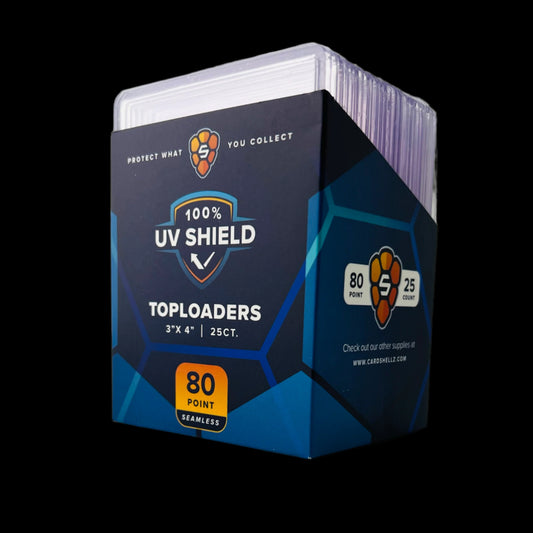If you collect trading cards, you've probably asked yourself: What size toploader do I need for my cards? It's one of the most common questions in the hobby, especially for collectors dealing with different card types, from Pokemon and standard base sets to thick relics and patch cards.
Choosing the right toploader size matters because a toploader that's too tight can damage corners, while one that's too loose lets cards slide around and risk falling out. With today's market where condition directly affects value, proper protection is essential.
This guide breaks down different top loader sizes, explains what "PT" means, and provides a handy size chart for base cards, patch cards, jersey cards, Pokémon cards, and oversized memorabilia.
Understanding Toploader Sizes
Toploader sizes are measured in points (PT), which describe the thickness of cards they can hold. One point equals 1/1000 of an inch:
-
A 35PT card is 0.035 inches thick
-
A 100PT card is 0.1 inches thick
If you're unsure what PT your card is, measure it with a ruler/caliper or use one of our business cards with a measuring guide on the back.
Rule of thumb: A snug (but not tight) fit protects best. If you have to force the card in, the toploader is too small.
Toploader Size Guide
Choosing the Right Toploader
Standard Trading Cards Most base cards fit in 35PT toploaders, including the majority of Topps, Bowman, Donruss, NBA Hoops, and Upper Deck sets.
Pokémon & Trading Card Games Pokémon, Magic: The Gathering, and Yu-Gi-Oh cards generally fit best in 20PT top loaders. Many collectors also use 35PT with premium thick Easy Glide penny sleeves.
Patch Cards, Jersey Cards & Relics These cards contain fabric or memorabilia pieces, making them thicker. Most fall into the 100PT to 180PT range. Panini National Treasures patch cards often require 130PT, while thicker Upper Deck hockey relics may need 180PT.
How to Measure Cards
-
Sleeve First: Place the card in a penny sleeve to protect the surface
-
Check Thickness: Use a ruler/caliper or card thickness gauge
- Match to PT: Find the closest toploader PT size that's equal or slightly larger
- Test Fit: Insert gently - the card should slide in without force and sit snugly
Penny Sleeves + Toploaders = Best Protection
Penny sleeves (thin plastic inner sleeves) are crucial because they prevent scratches and make insertion smoother. For maximum protection:
-
Card → penny sleeve → toploader → Glove-Fit bag (for storage/pricing/shipping)
Card Shellz Easy Glide Soft Sleeves are designed with a pre-cut specifically to make the sleeving process smoother without catching corners.
Common Collector Mistakes
-
Forcing a fit: Never jam a card into a too-tight top loader
-
Skipping the penny sleeve: Leaves the card surface vulnerable
- Using oversized loaders: Cards that slide inside can get corner damage
-
Stacking multiple cards in one loader: Not recommended for valuable cards. However, this is a common method for shipping multiple individually sleeved cards to customers.
Best Practices for Sleeving Trading Cards
-
Easy Glide Soft Sleeve: First line of defense for any card
-
Angle insertion: Always slide cards in at an angle to avoid corner dings
- Glove-fit dust sleeve or Team bags for stacks: Seal individual toploaders inside a Glove-fit sleeve to prevent dust and scratches. Seal groups of toploaders in team bags for shipping.
-
Avoid moisture and extreme temperatures: Keep collection in cool, dry spaces away from direct sunlight
FAQs
What size toploader do I need?
Most standard base cards fit 35PT toploaders. Pokemon and TCG cards usually go in 20PT, while patch or relic cards need 100PT–180PT. Oversized booklets may require 260PT–360PT.
What does PT mean in top loaders?
PT stands for "point," equal to 1/1000 of an inch. A 35PT card is 0.035 inches thick, while a 100PT patch is 0.1 inches thick.
What size toploader for Pokémon cards?
Most Pokémon cards fit best in 20PT toploaders, though many collectors use 35PT with thicker penny sleeves for added surface protection.
What size toploader for patch cards?
Patch, jersey, and relic cards usually need 100PT, 130PT, or 180PT toploaders. Panini National Treasures patches often land in 130PT, while Upper Deck hockey relics lean closer to 180PT.
Can one top loader size work for all cards?
No. 20PT–35PT loaders fit base cards, 55PT-75PT for premium releases, while thick relics and booklets require 100PT–360PT. Most collectors keep multiple sizes ready.
Final Thoughts
Understanding PT thickness makes finding the right top loader much easier:
-
Standard base cards: 35PT
-
Pokémon & TCG cards: 20PT–35PT
-
Patch, jersey, and relic cards: 100PT–180PT
-
Booklets & oversized memorabilia: 260PT–360PT
When in doubt, measure your card's thickness and match it to the closest PT size. Always use a penny sleeve inside your toploader and avoid forcing a card into a holder that feels too tight.
Ready to protect your collection? Shop our full selection of toploaders and find the perfect size for every card in your set.


